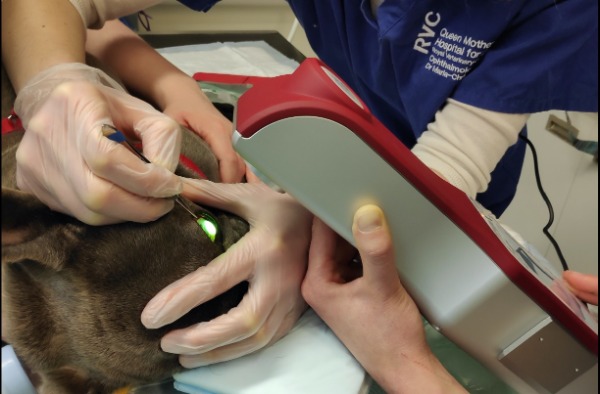
The in-vivo effect of photoactivated chromophore for keratitis cross-linking (PACK-CXL) on bacterial growth in canine patients with infectious keratitis
This study will investigate the effect of cross-linking using photoactivated riboflavin on the bacterial population present on the corneas and conjunctiva of canine patients with infectious ulcerative keratitis.

Challenge
Infectious keratitis (corneal ulceration) represents a vision-threatening condition in dogs. The bacterial pathogens and the white blood cells recruited to defend the cornea both release various proteases – these enzymes can rapidly breakdown the collagen molecules of the corneal stroma resulting in keratomalacia. This is colloquially termed ‘melting’ due to the appearance of the softened cornea. Infectious keratomalacia poses a high risk of corneal perforation and in worst-case scenarios loss of the eye. As such, the first-line treatment for ulcerative keratitis currently involves highly intense use of topical antibiotics; ideally based on cytology and culture and sensitivity results as treatment success relies on the pathogens being sensitive to the topical antimicrobials chosen. However, there is a global concern regarding the increase in antimicrobial resistance in both people and animals. It is of particular concern that bacteria causing infectious keratitis are increasingly found to have multidrug-resistant profiles in veterinary medicine. Furthermore, there is an increasing number of brachycephalic dogs in the canine population, who are predisposed to develop ulcerative keratitis. Thus, the increasing prevalence in infectious keratitis and the continued expansion of antimicrobial resistance are paramount in driving the development of non-traditional treatment options which reduce selection pressure promoting antibiotic resistance in bacteria.
Solution
PACK-CXL presents a non-antimicrobial option for disinfection of tissue and is independent of antimicrobial resistance patterns. Ultraviolet A light photoactivates riboflavin eye drops soaked into the corneal stroma. This limits microbial replication through DNA damage and releases reactive oxygen species that destroy bacterial cell walls. The antimicrobial effect of PACK-CXL has been shown both in vitro and in vivo in human ophthalmic studies. The second benefit of PACK-CXL is increased resistance to corneal melting; the released reactive oxygen species can force collagen molecules to form more covalent bonds between each other, thereby increasing the cornea’s ability to resist the effects of protease enzymes. PACK-CXL has successfully (74-100%) arrested corneal melting in human and veterinary patients. This pilot study aims to determine the ability of PACK-CXL to reduce bacterial load in canine patients with infectious keratomalacia in vivo using culture-based semi-quantitative and qualitative microbiological methods. It investigates the effect on both the infected ulcer (monitoring pathogen killing and any immediate re-infection) and the normal bacteria living in the conjunctival sack (to assess ‘knock-on’ effect on commensal bacterial microflora). Sampling will involve non-invasive swabs taken from the ulcer and conjunctival sac. Long-term clinical follow up will determine the rate of ulcer healing, return to corneal clarity and monitor for future reports of re-infection.
Impact
This study will determine if PACK-CXL can reduce the bacterial load at the ulcer site in vivo regardless of the antimicrobial resistance pattern. It will also determine if PACK-CXL affects the commensal ocular surface flora in the conjunctival sac, which is not treated with ultraviolet A light. This commensal ocular surface flora is non-invasive and thought to play an important role by competing with pathogenic species for space and nutrients, so using a treatment modality which has limited impact on the normal microflora may indirectly improve treatment outcome. If PACK-CXL proves to be an effective antimicrobial therapy in vivo, it would allow us to proceed with a randomised, prospective, controlled clinical trial comparing the treatment outcome of patients receiving PACK-CXL combined with conventional treatment and PACK-CXL treatment alone. The ultimate goal is reducing antimicrobial use and improving management of cases with keratomalacia caused by multidrug-resistant bacteria. Patients will potentially benefit from a reduced amount of stress associated application of medication, a reduced risk of vision loss and improved treatment outcomes. Further it will enable us to address the growing pressure on both medical and veterinary professionals to exercise caution with antimicrobial usage in a world where humans and their pets are interacting more closely and “One Health” is increasingly important.
